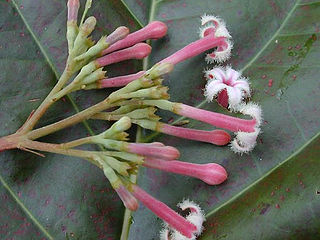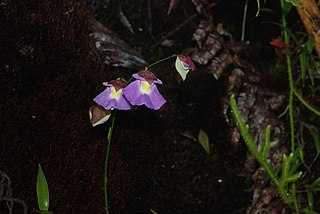
Myrciaria dubia, commonly known as camu-camu, caçari, araçá-d'água, or camocamo, is a species of plant in the family Myrtaceae. It is a small bushy riverside tree from the Amazon rainforest in Peru and Brazil, which grows to a height of 3–5 m (9.8–16.4 ft) and bears a red/purple cherry-like fruit. It is a close relative of the false jaboticaba and the guavaberry or rumberry. As much as 2 to 3% of the fresh fruit by weight is vitamin C.

Toxicodendron striatum is a South American poisonous tree in the family Anacardiaceae. It is commonly called manzanillo and grows in the tropical rain forests on low elevation slopes.

Iriartea is a genus in the palm family Arecaceae. It is native to Central and South America. The best-known species – and probably the only one – is Iriartea deltoidea, which is found from Nicaragua, south into Bolivia and a great portion of Western Amazonian basin. It is the most common tree in many forests in which it occurs.

Cinchona pubescens, also known as red cinchona and quina or kina, is native to Central and South America. It is known as a medicinal plant for its bark's high quinine content- and has similar uses to C. officinalis in the production of quinine, most famously used for treatment of malaria.
Aegiphila cordifolia is a species of flowering plant in the family Lamiaceae. It is endemic to Peru, where it occurs in the Amazon rainforest. It is sometimes found in disturbed habitat.

Campomanesia phaea is a species of plant in the family Myrtaceae. The plant is endemic to the Atlantic Forest ecoregion in southeastern Brazil. It is found in the states of Paraná, Rio de Janeiro, São Paulo.

Citronella mucronata, the huillipatagua, naranjillo, or Chilean citronella tree, is an evergreen tree in the family Cardiopteridaceae. It is endemic to Chile and grows in the Chilean matorral region of central Chile from 30º to 40° south latitude.

Utricularia unifolia is a species of perennial, medium-sized carnivorous plant that belongs to the family Lentibulariaceae. U. unifolia is native to Central America and western South America. It was originally published and described by Hipólito Ruiz López and José Antonio Pavón Jiménez in 1797 and later considered a synonym of Utricularia alpina until Peter Taylor's 1989 monograph on the genus where he restored the species as distinct from U. alpina. It grows as a terrestrial or epiphytic plant on moss-covered trees, rocks, or banks in cloud forests at altitudes between 2,000 m (6,562 ft) and 3,000 m (9,843 ft). U. unifolia usually produces only one leaf, which is where the species epithet "unifolia" is derived from.

Chondrodendron tomentosum is one of six accepted species in the small genus Chondrodendron, belonging to the Moonseed family Menispermaceae. It is a large tropical liana native to Central and South America. It contains highly toxic alkaloids and is one of the sources of the arrow poison curare – specifically 'tube curare', the name of which is derived from the name of the medicinally valuable alkaloid tubocurarine.

Tillandsia capillaris is a species of flowering plant in the family Bromeliaceae. This species is native to southern and western South America.

Carludovica palmata is a species of flowering plant in the family Cyclanthaceae. It is not a true palm, but its leaves are very similar compared to the leaves of some true palms, for example, to Chelyocarpus ulei. Unlike several true palms, C. palmata does not develop a woody trunk. Its female flowers have large stigmas, and its male flowers have a lot of pollen.
Maytenus macrocarpa is a tree species native to the Amazon rainforest; it grows in Bolivia, Colombia, Ecuador, Peru, Venezuela, and northern Brazil. With a maximum recorded height of about 30 metres (98 ft), and leaves that span up to 30 centimetres (12 in) wide, this large tree contributes significantly to the forest canopy.

Gaiadendron is a genus of parasitic shrubs or trees in the family Loranthaceae. It solely comprises the species Gaiadendron punctatum, which is found in North and South America.

Cavanillesia umbellata is a species of trees in the family Malvaceae. It is native to South America.
Tabernaemontana sananho is a tropical tree species in the family Apocynaceae known as lobo sanango. Lobo sanango grows in the Amazon Basin of northern South America.

Eccremocarpus scaber, the Chilean glory-flower or Chilean glory creeper, is a species of perennial plant in the family Bignoniaceae. It is found in Chile.

Escallonia resinosa is a species of evergreen shrub or tree in the family Escalloniaceae. It is native to the Andean forests of Peru, Bolivia and southern Ecuador from 2600 to 4200 meters above sea level. A component of high Andean forests, it is regarded as an important source of raw materials for the Andean peoples.

Fuchsia denticulata is a species of shrub in the family Onagraceae. It is native to Bolivia and Peru.

Escallonia paniculata is a species of tree in the family Escalloniaceae. It is native to Costa Rica, Panama and South America.

Hedyosmum racemosum is a species of tree in the family Chloranthaceae. It is native to South America.


















